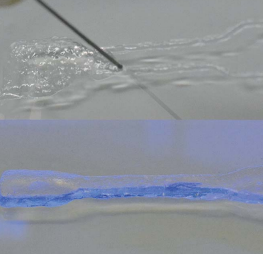 A technology that was once not accessible to the public, 3D printing is now highly visible. You’ll see plug-and-play 3D printers available at great prices in the most common of physical and online stores today, at your local libraries with patrons literally going to town making 3D models, and in a multitude of schools–even in quite rural areas.
A technology that was once not accessible to the public, 3D printing is now highly visible. You’ll see plug-and-play 3D printers available at great prices in the most common of physical and online stores today, at your local libraries with patrons literally going to town making 3D models, and in a multitude of schools–even in quite rural areas.
We’ve learned that we can use the technology in our own devices easily these days too–whether at home, at school, or in the office–to make fun and helpful items as well as creating complex projects and sharing them within the making community. And while its applications are far-ranging and we’ve all heard that it’s going to change the world–within the medical and scientific world, 3D printing is a technology that is already responsible for changing–and saving–lives.
So, while many of us are busy helping our kids figure out how to make their latest, favorite gaming figurines or we trying to see if indeed we could begin a mini-factory for our jewelry business directly out of our homes, scientists are in labs around the world using the technology to save your health, working to see if they can use 3D printers not only to fabricate and improve medical models and devices, but also to see if they can make new body parts altogether. And this has to begin with making cells.
While stunning progress is being made in what is termed ‘bioprinting,’ it all begins at the smallest level. We have followed numerous stories regarding more simple construction of tissue, as well as that of 3D printed scaffolding, being used more and more to regenerate biological materials such as bone and tissue.
Currently, Dr. Jingjin (Jenny) Qiu and her team of scientists from the Texas Tech University and Texas A&M University think they may have figured out a way to 3D print something which could transform what has become a very common procedure: knee surgery–and specifically, for repairing the commonly torn or injured meniscus.
The knee, made up of cartilage, is a part of our anatomy that takes a beating, as we all know, beginning from learning how to walk, ride bikes and then into a life of playing sports, running–and living. While the meniscus is meant to absorb all the friction and shock we throw its way, often on a constant basis, it can break down and become inflamed due to repeated sports moves, injuries, and conditions like arthritis. When the pain becomes too much, over a million patients annually now much more commonly turn to surgery for repairing the meniscus, at the advisement of their physicians.
In their recent paper, ‘3D printing of an extremely tough hydrogel,’ by Junhua Wei, Jilong Wang, Siheng Su, Shiren Wang, Jingjing Qiu, Zhenhuan Zhang, Gordon Christopher, Fuda Ning, and Weilong Cong, just published in RSC Advances, the team outlines how a key material may transform an entire industry. While the use of hydrogels has been in research for quite some time, scientists have not been successful in 3D printing with it until now, with the addition of a material known as alginate. A gel-like substance composed of a natural polysaccharide, alginate may be the key to bioprinting knee cartilage for the common meniscectomy, according to Qiu and her team.
“The addition of alginate not only increases the ink viscosity and printable period, but also improves its rheological characteristics towards precise processing control,” state the researchers in their paper. “Moreover, the entanglement of the alginate chains with the agar double network hydrogel restricts the agar helical chain bundles from pulling out under stress, which toughens the hydrogel.”
With the potential for 3D printing knee cartilage available, this could make a difference on two different levels. One, the common meniscectomy involves removing part of the meniscus, which may be detrimental later, possibly increasing the risk of osteoarthritis. Two, what’s really needed in these cases is a transplant of the knee cartilage, but that’s usually a challenge due to the usual biocompatibility issues, rejection issues, and a host of other complexities associated with transplants. With the 3D printed version, all of the problems could be eliminated–with numerous additional benefits offered like patient-specific customization, quality in product, and affordability.
“After decades of investigation by tissue engineers, all the primary results indicate that 3D printed hydrogels are the most promising solution for future meniscus substitutes based on their excellent performance as small tissue substitutes, like skin, vascular grafts, and tracheal splints,” state the researchers.
The 3D printed meniscus is created from the patient’s MRI, allowing for precision in fit. With the agar double network hydrogel, researchers believe they have finally found a material that will allow for high quality 3D printing, as well as complete functionality internally. Referred to as ‘super tough,’ the new hydrogel composed of the agar and alginate natural polymers was 3D printed on a Leapfrog Creatr 3D printer using a lightweight syringe pump and a thermal controller with a heating pad for the syringe. The researchers used Simply 3D to generate the G-code for the Leapfrog.
After much experimentation and time spent in the R&D lab, the scientists discovered that with alginate, the agar could be ‘extruded in the semi-gelled state, which ensured its quick gelling after extrusion.’ The alginate is responsible for toughening the gel and allowing it to offer the high performance and strength required for a load bearing tissue substitute. This new process offers a balanced, functional, and feasible method for 3D printing a biomaterial that is a great alternative to a real meniscus–and it may well lead the way to the 3D printing of organs, allowing for functional, strong mechanical performance.
What are your thoughts on yet another incredible medical application for 3D printing? Let us know in the 3D Printed Knee Cartilage forum thread on 3DPB.com.
Subscribe to Our Email Newsletter
Stay up-to-date on all the latest news from the 3D printing industry and receive information and offers from third party vendors.
You May Also Like
Further Understanding of 3D Printing Design at ADDITIV Design World
ADDITIV is back once again! This time, the virtual platform for additive manufacturing will be holding the first-ever edition of ADDITIV Design World on May 23rd from 9:00 AM –...
3D Printer Maker EVO-tech Reborn as NEVO3D — Once More With Feeling
EVO-tech was a 3D printing service and original equipment manufacturer established in 2013 and based in Schörfling am Attersee, Austria. The company produced high-quality material extrusion systems featuring linear bearings,...
3D Systems Brings 3D Printed PEEK Cranial Implant to the U.S. with FDA Clearance
For more than 10 years, 3D Systems (NYSE:DDD) has worked hand-in-hand with surgeons to plan over 150,000 patient-specific cases, and develop more than two million instruments and implants from its...
CDFAM Returns to Berlin for Second Annual Symposium
The second CDFAM Computational Design Symposium is scheduled for May 7-8, 2024, in Berlin, and will convene leading experts in computational design across all scales. Building upon the first event...


































